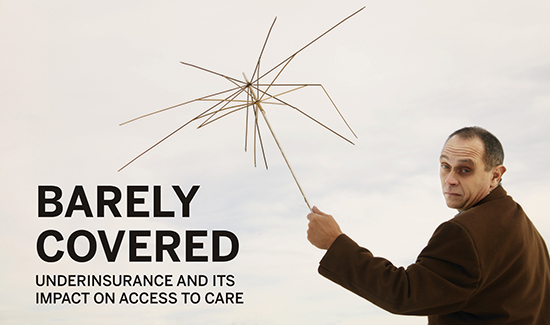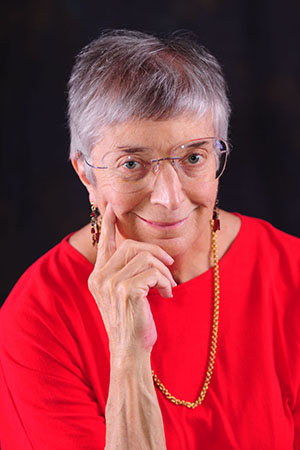Got Insurance? Don’t Be Too Sure
Shine Lecture: health policy expert on drawbacks to ACA, other plans

Judging just by the numbers, the health insurance picture in the United States keeps looking up. An estimated 20 million people gained health insurance coverage—a historic reduction in the uninsured—between the passage of the Affordable Care Act (ACA) in 2010 and early 2016, according to a new federal report released this month.
But for health policy expert and prolific author Emily Friedman, a contributing editor of Hospitals & Health Networks and a longtime writer for the Journal of the American Medical Association, the numbers disguise a more troubling story. Many of those covered by Medicare, Medicaid, or plans offered through the ACA exchanges or by employers face hefty copayments or deductibles, spiraling prescription drug costs, and often-unexpected barriers to care.
Navigating the insurance market’s tiers, each with a different level of coverage and network of providers, can be mind-boggling, Friedman says. And she worries that more and more consumers believe they have adequate coverage and access—when, in fact, they have neither.
“How difficult is it to find out what your insurance covers? Let me put it this way,” she says. “It would be easier to figure out the theory of relativity.”
Friedman, who has written more than 800 articles on health care quality, finance, and ethics in the past four decades, will deliver the annual Cathy Shine Lecture tomorrow on the Medical Campus. Sponsored by the School of Public Health Center for Health Law, Ethics & Human Rights, the lecture is endowed by the family of the late human rights advocate Cathy Shine, who died in 1992, in recognition of the work of George Annas, a William Fairfield Warren Distinguished Professor and an SPH, School of Medicine, and School of Law professor. Annas wrote about Shine’s experience of being restrained against her will at a Boston hospital recovering from an asthma attack and her subsequent avoidance of hospitals, and about the importance of respecting patients’ rights, in a frequently cited article in the New England Journal of Medicine.
Friedman’s talk, Barely Covered: Underinsurance and Its Impact on Access to Care, is her latest attempt to make sense of a law that she has called “a grand experiment, and a risky one.” While she has supported the ACA in concept, Friedman says, its implementation has been rife with problems, including a lack of effective cost-control provisions.
“The cost issue is the great black box of health care,” she says. “No one in the health care field can tell you what a service or procedure actually costs. The system is built on billing and benefits, not on actual costs.”
An SPH adjunct assistant professor of health law, policy, and management, Friedman was named one of the “Top 25 Women in Healthcare” by the editors of Modern Healthcare in 2005.
She spoke with BU Today about the challenges facing federal health care reform.

BU Today: The ACA has significantly reduced the number of uninsured Americans. Is there a downside to that coverage expansion?
Friedman: There is, if we look at the pool of people who supposedly have benefited by gaining access to insurance. The ACA has set up a tiered coverage system—the bronze, silver, gold, and platinum levels—with different deductibles and copays. At the silver level, the one that most people choose, the plans hinge on heavy cost sharing. Many of those people can’t afford the deductibles and copayments, and so providers are forced to cover the losses from caring for those patients.
The main reason I supported the ACA is because, in principle, it mandated that insurers could no longer discriminate against sick people. Insurers generally only want to cover healthy people, of course, but now they have to cover everyone. So what I was hoping they would do is to move from risk aversion to risk management: not just tending to the sick, but helping people to stay well. That didn’t happen. Instead, they started messing around with drug formularies and access.
How do you know if you’re underinsured?
If you do your homework, you can try to find out what the copays are, what the deductibles are, and what the medication formularies are. But 99 percent of the population is not going to do that. They find out when the bills arrive.
For example, my Blue Cross Blue Shield premium went up 35 percent this year, and there’s nothing I can do about it until the open enrollment period in the fall. And if you’re unlucky enough to have Parkinson’s disease or cancer or another serious illness, wait until you see those bills. Many insurers have manipulated their pharmaceutical formularies so that drugs for those conditions are in the highest cost-sharing tiers. If you are facing 40 percent cost sharing on a drug that costs $10,000 a month—well, talk about sticker shock.
We have a growing population of these underinsured. They are people who bought silver plans on the exchanges, with high cost sharing for pharmaceuticals and other services, or people who are in pockets of the country with extremely skimpy Medicaid plans. The law is too complicated, and the administration has done a terrible job of explaining it to people. That’s why it’s hard for people to even recognize that they’re underinsured.
Is cost the major issue?
It’s also a matter of expanding access to care. We now have this phenomenon of “narrow networks.” There’s a difference between coverage and access. Coverage means that you’ve got theoretical insurance, and providers are supposed to take it. Access means that some providers actually will take you as a patient. If you have coverage and nobody will take you, then your coverage is meaningless. For example, only about half of physicians in this country will accept Medicaid patients.
There are cases where doctors or hospitals simply get dropped out of the network of providers. In Harris County, Tex., for instance, most insurers excluded M. D. Anderson Cancer Center from their networks. In the same way, Medicare Advantage plans can drop your doctor anytime, and there’s nothing you can do about it. These are decisions that are driven by insurance companies, not by clinicians.
What about prevention? Is there any progress on that side of health care?
There’s no nice way to say this: nobody makes money on prevention. In some of my presentations, to illustrate this, I pick someone from the audience and say, ‘Look, he doesn’t have measles.’ I could do the same with Zika today.
The point is, prevention is not news. It’s just not sexy. Public health is underfunded and undervalued. If we funded our public health departments, if we respected our public health professionals, we would not have had a lot of the crises that we see today. It deserves so much more attention than we give it.
Emily Friedman will give the 2016 Cathy Shine Lecture, Barely Covered: Underinsurance and Its Impact on Access to Health Care, tomorrow, Wednesday, March 23, at noon in the School of Medicine Instructional Building Hiebert Lounge, 72 East Concord St. The lecture, followed by a reception, is free and open to the public.
Lisa Chedekel can be reached at chedekel@bu.edu.
Comments & Discussion
Boston University moderates comments to facilitate an informed, substantive, civil conversation. Abusive, profane, self-promotional, misleading, incoherent or off-topic comments will be rejected. Moderators are staffed during regular business hours (EST) and can only accept comments written in English. Statistics or facts must include a citation or a link to the citation.